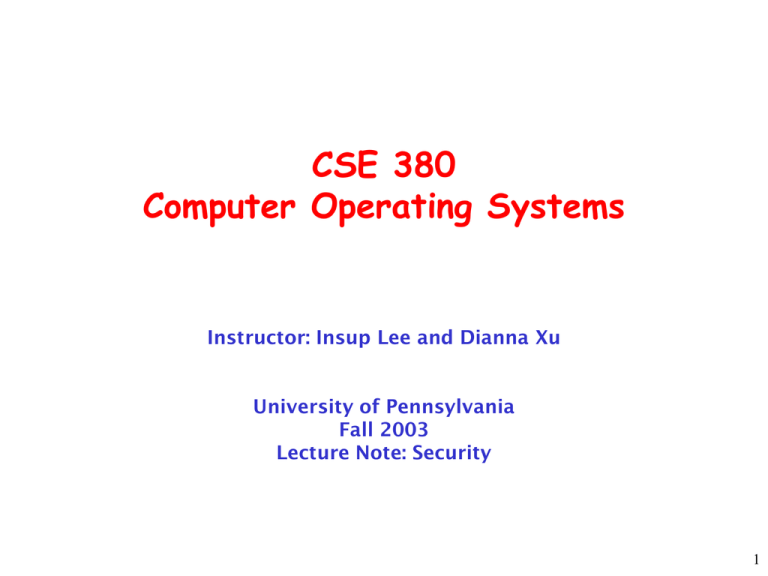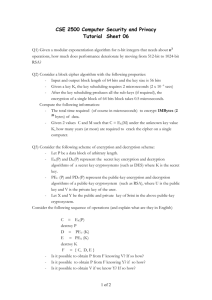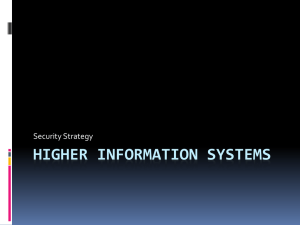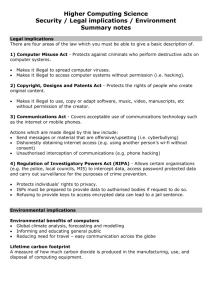CSE 380 Computer Operating Systems Instructor: Insup Lee and Dianna Xu
advertisement

CSE 380
Computer Operating Systems
Instructor: Insup Lee and Dianna Xu
University of Pennsylvania
Fall 2003
Lecture Note: Security
1
Preface
Early (unix systems) security
Security by obscurity
Those that know enough to break the system also know enough
not to
RTM
The Great Internet Worm of 1988
Devastating watershed event in hacker history
First awareness of internet security
Legendary literatures:
Hackers – Steven Levy
Cyberpunk – Hafner and Markoff
The Cuckoo’s Egg – Clifford Stoll
The Jargon File
2
Hackers vs Crackers
The word hack doesn’t have 69 different meanings
an appropriate application of ingenuity
a creative/brilliant practical joke
Legendary hacks are revered as urban folklores
The element of cleverness
A flare for classic hacker’s humor and style, which includes
references to Adams, Tolkien as well as jargons
Mostly harmless
Caltech/MIT football pranks
Robin Hood/Friar Tuck against Xerox
There is no cure against bored students
3
Robin Hood/Friar Tuck
!X id1
id1: Friar Tuck... I am under attack! Pray save me!
id1: Off (aborted)
id2: Fear not, friend Robin! I shall rout the Sheriff
of Nottingham's men!
id1: Thank you, my good fellow!
4
Terminology
Vulnerability (weakness/defects that can be exploited)
Ill-chosen passwords
Software bugs
Communication without encryption
Incorrect set-ups
Attack (ways of exploiting vulnerability)
Password crackers
Viruses and worms
Denial of service
Intruders (adversaries that try to attack)
Terrorists
Espionage
Hackers
5
Security Goals
Data Confidentiality
Keep data and communication secret
Privacy of personal financial/health records etc
Military and commercial relevance
Data Integrity
Protect reliability of data against tampering
Can we be sure of the source and content of information?
System Availability
Data/resources should be accessible when needed
Protection against denial of service attacks
6
Sample Tools
Cryptography
Can ensure confidentiality and integrity
Typically used for authentication
Firewalls, passwords, access control
Authorization mechanisms
Operating systems
Resource allocation
Monitoring and logging for audits
Java bytecode verifier
Memory safety against malicious/defective code
We do not have adequate technology today!
7
Basics
Terminology
Authentication: Verifying identity of sender and/or
message integrity
Integrity:
Message tampering detection
Plaintext:
Original message
Ciphertext:
Encrypted message
Key:
Input for en- and decryption algorithm
Encryption:
Plaintext + Key Ciphertext
Decryption:
Ciphertext + Key Plaintext
8
Basic Set-up of Cryptography
Relationship between the plaintext and the ciphertext
9
Encryption Algorithms
Symmetric
Encryption and decryption use the same key
Key must be secret (secret key)
Best known: DES, AES, IDEA, Blowfish, RC5
Asymmetric
Also known as Public Key Encryption
Encryption and decryption keys different
DES – Data Encryption Standard, IDEA – International Data Encryption Algorithm, AES – Advanced Encryption System
10
Symmetric Encryption
Out of band key exchange
Bob
Alice
Shared
key
Encryption
Shared
key
Confidentiality
Decryption
11
Monoalphabetic Ciphers
Classical way of encoding text strings (Caesar Cipher)
Permutation of the alphabet (rot13)
The key for decoding is the inverse permutation
Encoding and decoding are efficient
Theoretically sound: the number of permutations of ASCII
alphabet is VERY large (128!), and an intruder cannot possibly
try out all possible permutations to decipher
Main problem: Any human language has distinct frequent letter
(e.g. vowels) combos
E.g. e is the most common letter in English text, th is the most common
sequence of adjacent symbols
Given enough cipher text, one doesn’t need to be Shelock Holmes to
break the code
12
Secret-Key Cryptography
Sender and receiver share the secret key
This is also called symmetric key cryptography
A popular scheme for many years: DES (Data Encryption
Standard) promoted by NSA
Key is 56 bits (extended to 64 bits using 8 parity bits)
Input data is processed in chunks of 64-bit blocks, by subjecting
to a series of transformations using the key
Distribution of keys is a problem
13
Asymmetric Encryption
Two complementary keys
Private key (kept secret)
Public key (published)
Private key VERY difficult to compute from
public key
Encryption with one key can only be reversed
with the other key
Used in PGP (Pretty Good Privacy) &
PKI (Public Key Infrastructure)
Best known RSA & ECC, DSA for signatures
RSA Rivest Shami Adleman, ECC – Eliptic Curve Cryptography, DSA – Digital Signature Algorithm
14
One-Way Functions
Function such that given formula for f(x)
easy to evaluate y = f(x) given x
But given y
computationally infeasible to find x
There is a rich theory of one-way functions
Many candidates proposed
None of them “proved” to be one way
Existence of one-way functions linked to encryption, random
number generators, (and other crypto concepts) in a precise
sense
15
Asymmetric Encryption cont’d
Bob
Alice
Bob
Public
Confidentiality
Encryption
Encryption
Bob
Private
Decryption
Authentication & Integrity
Alice
Private
Decryption
Alice
Public
16
Public-Key Cryptography
All users pick a public key/private key pair
publish the public key
private key not published
Public key is the encryption key
To send a message to user Alice, encrypt the message with
Alice’s public key
Private key is the decryption key
Alice decrypts the ciphertext with its private key
Popular schemes (1970s): Diffie-Hellman, RSA
17
More on RSA
Introduced by Rivest, Shamir, and Adleman in 1979
Foundations in number theory and computational difficulty of
factoring
Not mathematically proven to be unbreakable, but has withstood
attacks and analysis
Ideally, we would like to prove a theorem saying “if intruder does not know
the key, then it cannot construct plaintext from the ciphertext by executing a
polynomial-time algorithm”
Public and private keys are derived from secretly chosen large prime
numbers (512 bits)
Plaintext is viewed as a large binary number and encryption is
exponentiation in modulo arithmetic
Intruder will have to factor large numbers (and there are no known
polynomial-time algorithms for this)
2002’s major result: polynomial-time test to check if a number is prime
18
Hash Functions
Produce hash values for data access or security
Hash value: Number generated from a string of
text
Hash is substantially smaller than the text itself
Unlikely that other text produces the same hash
value (collision resistance)
Unidirectional (cannot calculate text from hash)
Provides: Integrity & Authentication
Best known: SHA-1 & MD5
SHA – Secure Hash Algorithm, MD5 – Message Digest
19
Digital Signatures
How can Alice sign a digital document ?
Let S(A,M) be the message M tagged with Alice’s
signature
No forgery possible: If Alice signs M then nobody else
can generate S(A,M)
Authenticity check: If you get the message S(A,M) you
should be able to verify that this is really created by
Alice
No alteration: Once Alice sends S(A,M), nobody
(including Alice) can tamper this message
No reuse: Alice cannot duplicate S(A,M) at a later time
20
Digital Signatures with Public Keys
Suppose K is public key and k is private key for Alice, and
encryption/decryption is commutative:
D(E(M,K), k) = E(D(M,k),K)=M
To sign a message M, Alice simply sends D(M,k)
Receiver uses Alice’s public key to compute E(D(M,k),K), to
retrieve M
Authenticity of signature because only Alice knows the private key k
RSA encryption does satisfy the required commutativity
To ensure “no reuse” and “no alteration” the message must
include a timestamp
The scheme is made more efficient by computing D(H(M),k),
where H(M) is the secure hash of M
Hashing gives a constant size output
Hard to invert
21
Hash Functions cont’d
Provides signatures with
shared secret
Alice
Message Secret
Hash
+
Bob
Message Secret
Message
Hash
?=
Hash
22
Hash Functions cont’d
Provides signatures with
public key
Alice
Message
Hash
Hash
Encryption
Decryption
Bob
Message
?=
Hash
Alice
Private
Alice
Public
23
PKI in a Nutshell
PKI (Public Key Infrastructure) based on
Certificates (X.509)
Chain of trust (usually hierarchy)
Certificates
Public keys signed by a trusted 3rd party
CA = Certificate Authority
Certificate is public as well
Different types for people, web server, …
24
Certificate creation
Alice
CA
Certificate Signing Request (CSR)
Certificate
CA Certificate
Identity Verification
25
User Authentication
Authentication is the process of determining which user
is making a request
Basic Principles. Authentication must identify:
1. Something the user knows (e.g. password)
2. Something the user has (e.g. ID card)
3. Something user is (e.g. retina scan)
Humans are the weakest link
26
Passwords
The most commonly used way of authentication
Vulnerabilities
Stealing passwords
Poorly chosen passwords that are easy to guess
Attacks that search through password directories
If you were to guess passwords, how would you go
about doing that?
Survey of passwords by Morris&Thomson: could guess
86% of all passwords
15 single ASCII letters
72 two ASCII letters
464 three ASCII letters
Words from dictionary, names of people/streets ….
27
Systems are easy to crack!
How a cracker broke into LBL
a U.S. Dept. of Energy research lab
28
Password Attacks
Deadly combo:
War dialers / password guessing
Once entrance to a system is gained:
password file
packet sniffer
rsh/rlogin into other machines with known usr/passwd
combo
Social Engineering
29
Unix: /etc/passwd
Passwords stored in a file system are vulnerable to
automated attacks
At first Unix was implemented with a password file holding
the actual passwords of users, but with only root permissions.
This had many vulnerabilities
Copies were made by privileged users
Copies were made by bugs: classic example posted password
file on daily message file
30
Improvements to First Approach
Enforce password rules
Makes the passwords harder to guess or crack with dictionaries
Problems?
Hashing and encryption: use password to create a key,
then hash based on the DES algorithm for encryption
Speed OK for legitimate users
Takes longer to do automatic search
Password files contains these encrypted entries
Intruder cannot figure out the passwords just by
gaining access to password file, but can keep guessing
passwords, apply hash/encryption and compare the
results to entries in password file
31
Add Salt
“Salt” the passwords by adding random bits.
Makes dictionary attacks more expensive.
Decreases the likelihood that two identical passwords
will appear as identical entries in the password file.
12 bit salt results in 4,096 versions of each
password.
/etc/passwd entry:
user_id Salt Hash(salt + passwd)
…
How does this help?
32
Hash-based 1-time Passwords
Goal: Can the password be different in every session?
code books
Scheme used for remote logins based on one-way
hash functions
One-time setup.
User chooses a password w
Fixes a constant t for the number of times the authentication
can be done using password w
User declares the password Ht(w) to the system the first time
H(H(H…(H(w))…))
33
One time passwords
Initially, the computer stores, with user’s login-id,
password p=Ht(w) and session number s=0
After i sessions the computer has p=Ht-i(w) and s=i
At the time of login, computer sends i to the user
User computes new password q=Ht-i-1(w) and sends it to
the computer
The computer checks that H(q)=p, and if so, allows the
login (and updates local entries to q and i+1)
Important property: given q, it is easy to compute H(q),
but if intruder had stolen p in the last session, it cannot
produce q
H is a one-way hash function, hard to invert
34
Operating System Security
Trojan horses
Free programs available to be downloaded and executed
Common trick: place altered versions of utility programs in
user directories
Login Spoofing
Simulate the login session to acquire passwords
Logic Bomb
Trap Doors
System programmer writes code to bypass normal checks
Insider knowledge to exploit these intentional vulnerabilities
35
Buffer Overflow Attacks
> 50% of security incidents reported at CERT (see
cert.org) are due to buffer overflow attacks
C and C++ programming languages don’t do
array bounds checks
In particular, widely used library functions such as strcpy,
gets
Exploited in many famous attacks (read your
Windows Service Pack notes)
36
C’s Control Stack
g(char *args) {
int x;
// more local
// variables
...
}
Larger Addresses
f() {
g(parameter);
}
SP
Input
parameter
f’s stack frame
Before calling g
37
C’s Control Stack
g(char *args) {
int x;
// more local
// variables
...
}
SP
Larger Addresses
f() {
g(parameter);
}
int x;
// local
// variables
base pointer
return address
Input
parameter
f’s stack frame
After calling g
38
Buffer Overflow Example
buffer[]
g(char *text) {
char buffer[128];
strcpy(buffer, text);
}
text
base pointer
return address
Attack code
128 bytes
…
ADDR
f’s stack frame
39
Buffer Overflow Example
ADDR buffer[]
Attack code
128 bytes
g(char *text) {
char buffer[128];
strcpy(buffer, text);
}
text
base …
pointer
return
ADDR
address
Attack code
128 bytes
…
ADDR
Upon return from g, attack code gets executed !
f’s stack frame
40
Solutions
Don’t write code in C
Use a safe language instead (Java, C#, …)
Not always possible (low level programming)
Doesn’t solve legacy code problem
Link C code against safe version of libc
May degrade performance unacceptably
Software fault isolation
Instrument executable code to insert checks
Program analysis techniques
Examine program to see whether “tainted” data is used
as argument to strcpy
41
Avoiding Titanics
Unix
lpr
link core to /etc/passwd
Microsoft
code red (buffer overflow in IIS Indexing Service)
Weathering actual attacks is the best way to
make an OS safe
tiger teams
System design should be public
Keep the design simple
42
Network Security
External threat
code transmitted to target machine
code executed there, doing damage
Goals of virus writer
quickly spreading virus
difficult to detect
hard to get rid of
Virus = program can reproduce itself
by attaching its code to another program
additionally, do harm
Worm
self-replicating
43
The Morris Internet Worm
44
Virus Attachment: Append
Virus
Original
Program
Simplest case: insert copy at the end of an
executable file
Runs before other code of the program (by
changing start address in header)
Most common program virus
45
Kinds of Viruses
Overwriting Viruses
Companion Viruses
Executable Viruses
Parasitic Viruses
Cavity Viruses
Memory-resident Viruses
System-call-trap Viruses
Software Viruses (Windows manager, explorer, etc)
Boot Sector Viruses
Device Driver Viruses
Macro Viruses
46
Bootstrap Viruses
MBR
boot
boot
Bootstrap Process:
Firmware (ROM) copies MBR (master boot record) to
memory, jumps to that program
MBR (or Boot Sector)
Fixed position on disk
“Chained” boot sectors permit longer Bootstrap
Loaders
47
Bootstrap Viruses
MBR
boot
virus
boot
Virus breaks the chain
Inserts virus code
Reconnects chain afterwards
48
Why the Boot Sector?
Automatically executed before OS is running
Also before detection tools are running
OS hides boot sector information from users
Hard to discover that the virus is there
Harder to fix
Any good virus scanning software scans the
boot sectors
49
Macro Viruses
Macros are just programs
Word processors & Spreadsheets
Startup macro
Macros turned on by default
Visual Basic Script (VBScript)
50
Melissa Virus
Transmission Rate
The first confirmed reports of Melissa were received on
Friday, March 26, 1999.
By Monday, March 29, it had reached more than
100,000 computers.
One site got 32,000 infected messages in 45 minutes.
Damage
Denial of service: mail systems off-line.
Could have been much worse
51
Melissa Macro Virus
Implementation
VBA (Visual Basic for Applications) code associated with
the "document.open" method of Word
Strategy
Email message containing an infected Word document as an
attachment
Opening Word document triggers virus if macros are enabled
Propagation
Sends email message to first 50 entries in every Outlook
address book readable by the user executing the macro
52
“I Love You” Virus/Worm
Infection Rate
At 5:00 pm EDT May 8, 2000, CERT had received reports from more than
650 sites
> 500,000 individual systems
VBScript
Propagation
Email, Windows file sharing, IRC, USENET news
Signature
An attachment named
"LOVE-LETTER-FOR-YOU.TXT.VBS"
A subject of "ILOVEYOU"
Message body: "kindly check the attached LOVELETTER coming from
me."
53
Love Bug Behavior
Replaced certain files with copies of itself
Based on file extension (e.g. .vbs, .js, .hta, etc)
Changed Internet Explorer start page
Pointed the browser to infected web pages
Mailed copies of itself
Changed registry keys
54
Antivirus and Anti-Antivirus Techniques
Scanning the disk for certain executables
hard to deal with polymorphic viruses
Integrity checkers using checksums
Behavioral checkers
Virus avoidance
good OS
install only shrink-wrapped software
do not click on attachments to email
use antivirus software
frequent backups
Recovery from virus attack
halt computer, reboot from safe disk, run antivirus
55



